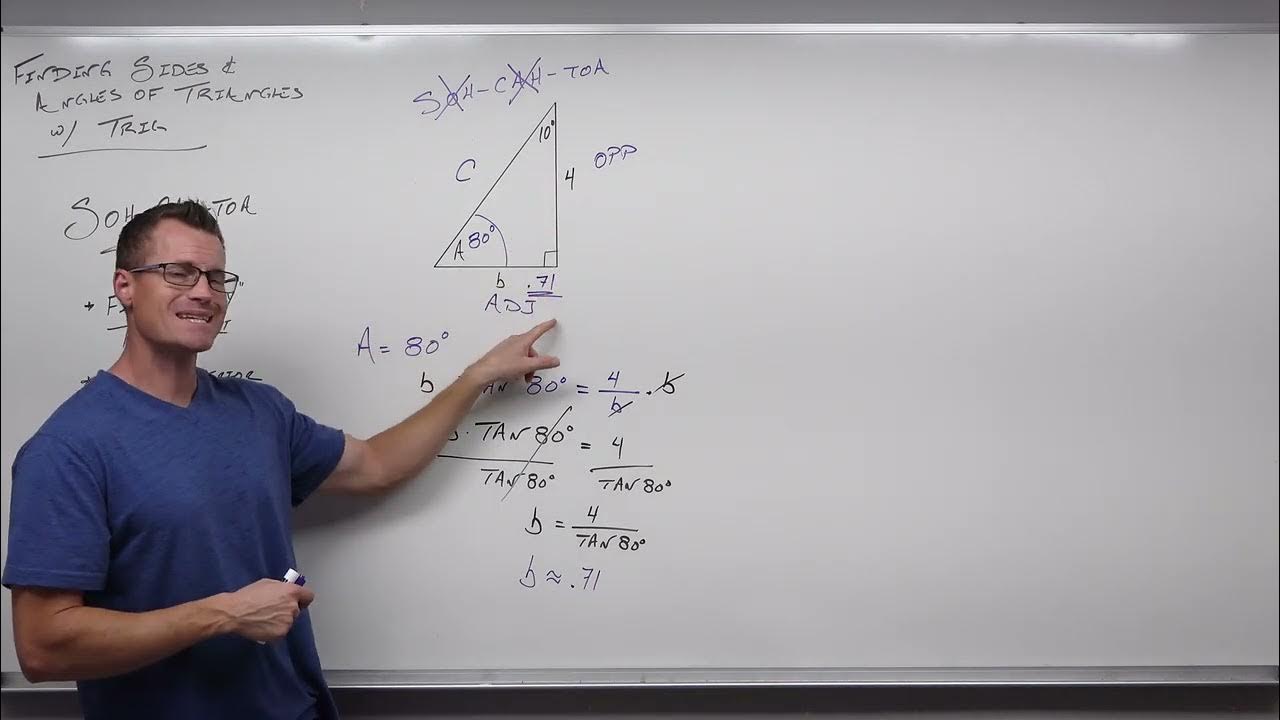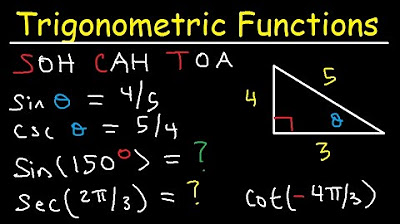Trigonometry - How To Solve Right Triangles
TLDRThis educational video script provides a step-by-step guide on solving right triangles. It begins by explaining how to find missing angles using the fact that the sum of angles in a triangle equals 180 degrees. The script then delves into trigonometry, introducing the 'sohcahtoa' mnemonic to find unknown sides using sine, cosine, and tangent functions. It demonstrates the process using examples, first calculating the hypotenuse and then using the Pythagorean theorem to find the missing side. The script also shows how to use the inverse tangent function to determine angles when sides are known. The goal is to find all angles and sides of a right triangle, with clear instructions and examples to help viewers understand the concepts.
Takeaways
- 📐 The sum of angles in a right triangle always equals 180 degrees, with one angle being a right angle at 90 degrees.
- 🔍 To find the missing angles in a right triangle, you can subtract the known angles from 180 degrees.
- 📏 Trigonometric ratios (sine, cosine, and tangent) are essential for calculating unknown sides in a right triangle.
- 📚 The acronym 'sohcahtoa' helps remember the trigonometric ratios: sine (opposite/hypotenuse), cosine (adjacent/hypotenuse), and tangent (opposite/adjacent).
- 🧭 Cosine can be used to find the hypotenuse when the adjacent side and an angle are known.
- ✂️ The Pythagorean theorem (a² + b² = c²) is a fundamental tool for solving right triangles when two sides are known.
- 📉 To find an unknown side using the Pythagorean theorem, subtract the square of the known side from the square of the hypotenuse and take the square root of the result.
- 📐 The tangent ratio helps find an angle when the lengths of the opposite and adjacent sides are known.
- 🔄 The inverse tangent function (arctan or tan^-1) is used to calculate the angle when the tangent value is known.
- 📈 The process of solving a right triangle involves using trigonometric functions and the Pythagorean theorem to find all unknown sides and angles.
- 👍 The video provides step-by-step examples demonstrating how to apply these concepts to solve right triangles.
Q & A
What is the sum of the angles in a right triangle?
-The sum of the angles in a right triangle is 180 degrees.
If one angle of a right triangle is 30 degrees and another is 90 degrees, what is the measure of the third angle?
-The third angle is 60 degrees, since the sum of the angles must be 180 degrees.
What is the relationship between the angles and sides in a right triangle?
-In a right triangle, the sides and angles are related through trigonometric functions such as sine, cosine, and tangent.
How do you find the length of the hypotenuse in a right triangle if one side and one angle are known?
-You can use the cosine function. For example, if you know angle A and side b, then cos(A) = adjacent (b) / hypotenuse (c).
What is the value of cosine 30 degrees?
-Cosine 30 degrees is equal to the square root of 3 over 2, which is approximately 0.866.
How can you find the missing side length using the Pythagorean theorem?
-Use the formula a^2 + b^2 = c^2, where a and b are the legs and c is the hypotenuse. Solve for the missing side.
What is the formula for calculating sine of an angle?
-Sine of an angle is calculated as the opposite side divided by the hypotenuse.
How do you find an angle in a right triangle using the tangent function?
-Use the formula tan(A) = opposite / adjacent. To find the angle, use the inverse tangent function (arctan).
What are the steps to calculate a missing angle in a right triangle?
-First, use known side lengths and trigonometric functions (sine, cosine, tangent) to find the angle. Then, use inverse functions if needed.
How do you calculate the remaining angles once you have one angle and the right angle?
-Subtract the known angle and the right angle (90 degrees) from 180 degrees to find the missing angle.
Outlines
📚 Introduction to Solving Right Triangles
This paragraph introduces the concept of solving right triangles using trigonometry. It explains that if you know the length of one side and one angle, you can calculate the other sides and angles. The video begins by identifying the angles of a right triangle, which must sum up to 180 degrees, and demonstrates how to find the missing angle using basic angle arithmetic. The paragraph then labels the sides and angles and introduces the trigonometric ratios sine, cosine, and tangent, which are essential for solving the triangle. It uses the example of a triangle with a known side length of 12 units and explains how to calculate the hypotenuse using the cosine ratio.
🔍 Calculating Sides and Angles Using Trigonometry
This paragraph continues the discussion on solving right triangles by focusing on the calculation of unknown sides and angles. It first demonstrates how to find the hypotenuse using the cosine of 30 degrees and the known side length of 12 units. The process involves using the cosine value and cross-multiplying to solve for the hypotenuse, which is found to be 8 square root of 3 units. The paragraph then moves on to use the Pythagorean theorem to find the remaining side length, 'a', which is calculated to be 4 square root of 3 units. The video also provides an example of how to solve for the missing side and angles in a different right triangle, where side 'a' is 21 units and the hypotenuse 'c' is 29 units. It uses the Pythagorean theorem to find the missing side 'b', which is 20 units, and introduces the tangent function to calculate angle 'a' using the inverse tangent function.
📐 Final Calculations and Conclusion
In the final paragraph, the video concludes the process of solving right triangles. It shows how to calculate the remaining angle 'b' by subtracting the known angles from 180 degrees, resulting in an angle 'b' of 43.6 degrees. The video emphasizes that the process can be simplified for right triangles by using the relationship between the angles and the right angle. It wraps up by encouraging viewers to subscribe to the channel and hit the notification bell, and thanks them for watching the tutorial on solving right triangles.
Mindmap
Keywords
💡Right Triangle
💡Trigonometry
💡Sine
💡Cosine
💡Hypotenuse
💡Pythagorean Theorem
💡Tangent
💡Inverse Trigonometric Functions
💡Sohcahtoa
💡Angle Calculation
Highlights
Introduction to solving right triangles using given side length and angle.
Explanation of the sum of angles in a right triangle being 180 degrees.
Calculating the missing angle using the sum of angles property.
Labeling the angles and sides of the triangle for clarity.
Introduction to trigonometry and the SOHCAHTOA mnemonic.
Using sine function to find the side opposite to a given angle.
Cosine function application to find the adjacent side relative to an angle.
Cross-multiplication method to calculate the hypotenuse.
Calculation of the hypotenuse using cosine and given side lengths.
Rationalizing the denominator to simplify the hypotenuse calculation.
Introduction to the Pythagorean theorem for calculating missing side lengths.
Demonstration of calculating a missing side using the Pythagorean theorem.
Introduction to tangent function for angle calculation.
Using tangent and the inverse tangent function to find an angle.
Calculating the remaining angle in a right triangle.
Explanation of the process to solve any right triangle given missing elements.
Second example problem demonstrating the process.
Final summary of the steps needed to solve a right triangle.
Transcripts
Browse More Related Video

Trigonometry: Finding missing sides and angles

How To Solve Two Triangle Trigonometry Problems

Trigonometry For Beginners!

Finding Sides and Angles with Right Triangle Trigonometry (Precalculus - Trigonometry 31)

Introduction to Right Triangle Trigonometry (Precalculus - Trigonometry 30)

Trigonometric Functions of Any Angle - Unit Circle, Radians, Degrees, Coterminal & Reference Angles
5.0 / 5 (0 votes)
Thanks for rating: